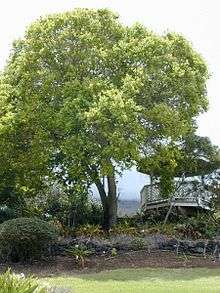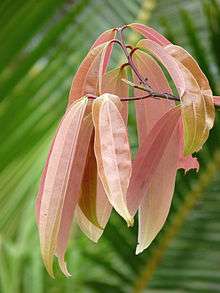Cinnamomum
| Cinnamomum | |
|---|---|
 | |
| Cinnamomum camphora | |
| Scientific classification | |
| Kingdom: | Plantae |
| (unranked): | Angiosperms |
| (unranked): | Magnoliids |
| Order: | Laurales |
| Family: | Lauraceae |
| Genus: | Cinnamomum Schaeff. |
| Species | |
|
See text. | |
| Synonyms | |

Cinnamomum is a genus of evergreen aromatic trees and shrubs belonging to the laurel family, Lauraceae. The species of Cinnamomum have aromatic oils in their leaves and bark. The genus contains over 300 species, distributed in tropical and subtropical regions of North America, Central America, South America, Asia, Oceania, and Australasia. The genus includes a great number of economically important trees.
Habitat
This genus is present in Himalayas and other mountain areas and is present in tropical and subtropical montane rainforest, in the weed-tree forests, in valleys, and mixed forests of coniferous and deciduous broad-leaved trees, from southern China, India, and Southeast Asia. Some species, such as Cinnamomum camphora, tolerate drought.
Characteristics
All species tested so far are diploid, with the total number of chromosomes being 24.[1] This Lauraceae genus comprises more than 270 trees and shrubs and most are aromatic. Some trees produce sprouts. The thick, leathery leaves are dark green, lauroid type. Laurophyll or lauroid leaves are characterized by a generous layer of wax, making them glossy in appearance, and narrow, pointed oval in shape with an 'apical mucro', or 'drip tip', which permits the leaves to shed water despite the humidity, allowing respiration from plant.
Mostly, the plants present a distinct odor. Their alternate leaves are ovate-elliptic, with margins entire or occasionally repand, with acute apices and broadly cuneate to subrounded bases. Upper leaf surfaces are shiny green to yellowish-green, while the undersides are opaque and lighter in color. Mature leaves are dark green. Young leaves are reddish brown to yellowish-red. The leaves are glabrous on both surfaces or sparsely puberulent beneath only when young; the leaves are mostly triplinerved or sometimes inconspicuously five-nerved, with conspicuous midrib on both surfaces. The axils of lateral nerves and veins are conspicuously bullate above and dome-shaped. Terminal buds are perulate.
The axillary panicle is 3.5–7 cm long. It is a genus of monoecious species, with hermaphrodite flowers, greenish white, white to yellow are glabrous or downy and pale to yellowish brown. Mostly the flowers are small. The perianth is glabrous or puberulent outside and densely pubescent inside. The purplish-black fruit is an ovate, ellipsoidal or subglobose drupe. The perianth-cup in fruit is cupuliform.
Selected species
About 250 species are known, including several commercially important ones.
Cinnamomum parthenoxylon and Cinnamomum camphora are large evergreen trees that can grow to 30 m in height and 3 m in diameter, with broadly ovate crowns. Terminal buds are broadly ovoid or globular, and covered with sericeous scales. Bark is yellowish-brown with irregular vertical splits. Branches are light brown, cylindrical, and glabrous.



The inner bark of several species is used to make the spice, cinnamon. Other notable species are C. tamala, used as the herb malabathrum (also called tejpat and Indian bay leaf), and C. camphora, from which camphor is produced.
- Cinnamomum acuminatifolium
- Cinnamomum acuminatissimum
- Cinnamomum acutatum
- Cinnamomum africanum
- Cinnamomum aggregatum
- Cinnamomum alainii
- Cinnamomum alatum
- Cinnamomum albiflorum
- Cinnamomum alcinii
- Cinnamomum alexei
- Cinnamomum alibertii
- Cinnamomum alternifolium
- Cinnamomum altissimum
- Cinnamomum ammannii
- Cinnamomum amoenum
- Cinnamomum amplexicaule
- Cinnamomum amplifolium
- Cinnamomum anacardium
- Cinnamomum andersonii
- Cinnamomum angustifolium
- Cinnamomum angustitepalum
- Cinnamomum antillarum
- Cinnamomum appelianum
- Cinnamomum arbusculum
- Cinnamomum archboldianum
- Cinnamomum areolatocostae
- Cinnamomum areolatum
- Cinnamomum arfakense
- Cinnamomum argenteum
- Cinnamomum arsenei
- Cinnamomum asa-grayi
- Cinnamomum assamicum
- Cinnamomum aubletii
- Cinnamomum aureo-fulvum
- Cinnamomum australe
- Cinnamomum austro-sinense
- Cinnamomum austro-yunnanense
- Cinnamomum bahianum
- Cinnamomum bahiense
- Cinnamomum baileyanum
- Cinnamomum baillonii
- Cinnamomum balansae
- Cinnamomum bamoense
- Cinnamomum barbato-axillatum
- Cinnamomum barbeyanum
- Cinnamomum barlowii
- Cinnamomum bartheifolium
- Cinnamomum barthii
- Cinnamomum bazania
- Cinnamomum beccarii
- Cinnamomum bejolghota
- Cinnamomum bengalense
- Cinnamomum biafranum
- Cinnamomum bintulense
- Cinnamomum birmanicum
- Cinnamomum blumei
- Cinnamomum bodinieri
- Cinnamomum bonii
- Cinnamomum bonplandii
- Cinnamomum borneense
- Cinnamomum bourgeauvianum
- Cinnamomum boutonii
- Cinnamomum brachythyrsum
- Cinnamomum bractefoliaceum
- Cinnamomum burmannii - Indonesian cinnamon
- Cinnamomum camphora - camphor laurel
- Cinnamomum cassia - (C. aromaticum) Chinese cinnamon also called cassia
- Cinnamomum caudiferum
- Cinnamomum chartophyllum
- Cinnamomum citriodorum - Malabar cinnamon
- Cinnamomum contractum
- Cinnamomum dubium - Wild cinnamon
- Cinnamomum elegans
- Cinnamomum filipes
- Cinnamomum glanduliferum
- Cinnamomum glaucescens
- Cinnamomum ilicioides
- Cinnamomum impressinervium
- Cinnamomum iners
- Cinnamomum japonicum - (C. pedunculatum Japanese cinnamon)
- Cinnamomum javanicum
- Cinnamomum jensenianum
- Cinnamomum kanehirae - (stout camphor tree niu zhang (Chinese: 牛樟); endemic to Taiwan)
- Cinnamomum kotoense
- Cinnamomum kwangtungense
- Cinnamomum liangii
- Cinnamomum longepaniculatum
- Cinnamomum longipetiolatum
- Cinnamomum loureiroi - (Saigon cinnamon)
- Cinnamomum mairei
- Cinnamomum micranthum
- Cinnamomum migao
- Cinnamomum mercadoi Vidal - (kalingag tree)
- Cinnamomum mollifolium
- Cinnamomum oliveri
- Cinnamomum osmophloeum - (pseudocinnamomum)
- Cinnamomum ovalifolium
- Cinnamomum parthenoxylon - (Selasian wood, Martaban camphor wood, saffrol laurel, alcanforero amarillo, mreah prew phnom, kayu gadis, telasihan, huang zhang (Chinese: 黃樟))
- Cinnamomum pauciflorum
- Cinnamomum philippinense
- Cinnamomum pingbienense
- Cinnamomum pittosporoides
- Cinnamomum platyphyllum
- Cinnamomum porphyrium
- Cinnamomum porrectum
- Cinnamomum reticulatum
- Cinnamomum rigidissimum
- Cinnamomum saxatile
- Cinnamomum septentrionale
- Cinnamomum sinharajaense
- Cinnamomum sintoc Blume
- Cinnamomum subavenium
- Cinnamomum tamala - (tejpat, Indian bay leaf, or malabathrum)
- Cinnamomum tenuipilum
- Cinnamomum tonkinense
- Cinnamomum triplinerve
- Cinnamomum tsangii
- Cinnamomum tsoi
- Cinnamomum validinerve
- Cinnamomum verum - (cinnamon, Ceylon cinnamon, or true cinnamon)
- Cinnamomum virens - (red-barked sassafras, eastern Australia)
- Cinnamomum wilsonii
References
External links
| Wikimedia Commons has media related to Cinnamomum. |
| Wikispecies has information related to: Cinnamomum |